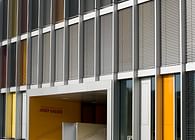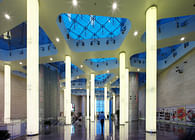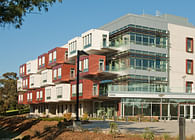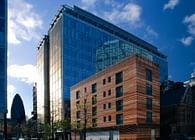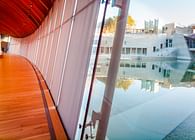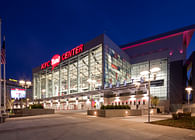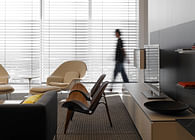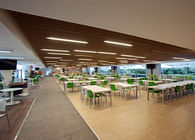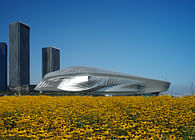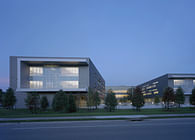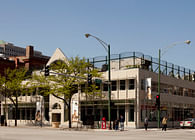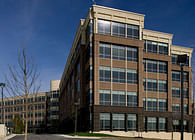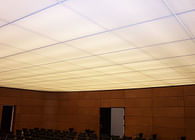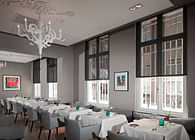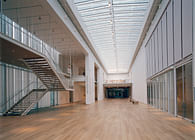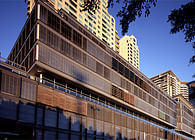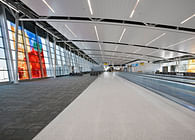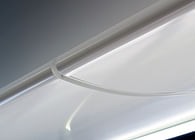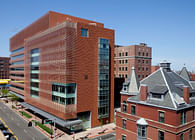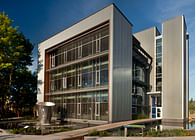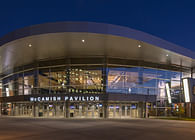
Pearl River, NY
What happens when solar control becomes sculpture-and vice versa?
Architects at Gould Evans had just such an opportunity for the second of four buildings that make up Arizona State University's Biodesign Institute. The building's north façade, an entry point for the entire research complex, lies on what will become a major pedestrian path, framing a mall with connections to a light rail station. Seizing the moment, the school set aside a small budget specifically for an artistic gesture at this prominent entrance.
From the start, Gould Evans had envisioned an atypical laboratory complex wrapped in glass, observable to the outside world and as bright and open as possible within. This visibility of research also inspired the architects to refer to the science contained within, however abstractly, in its proposed sculptural piece. Lined with offices and conference rooms, the north and east sides of the ingress building would also need solar control for early morning and late afternoon sun. Ideally the shading would be adaptable and user controlled, permitting views and adjustments by occupants. The constraints played into their conceptual thinking, which was rendered in aerofoil-shaped custom wood louvers by the Hunter Douglas Contract division, Nysan Shading Systems.
"Our inspiration came from the scientists' and researchers' work, and the process known as gel electrophoresis," explains John Dimmel, a design architect for GouldEvans who also oversaw construction administration for this second phase.
Gel eletrophoresis refers to a standard technique for separating molecules based on their shape or size-a process ideal for the DNA sequencing undertaken at the Biodesign Institute. The output is interpreted by means "gel arrays," which show patterns of "DNA ladders" familiar to anyone who has studied biology in recent decades. "So we looked at some gel arrays, and that was our starting point," says Dimmel. "The clients really liked the idea."
Like the gel arrays, the exterior would have both horizontal and vertical banding. Another early guideline was to keep costs low. "We only had a fixed amount of money to work with, so we originally considered flat panels," for the sun control, says Dimmel. "The original idea was essentially moving doors, and we suggested a fabricated louver that at 40 inches or so would be larger than typical," says Jason Warnock, Nysan's director of sales and marketing. The secret to cost control was using the same airfoil geometry Nysan had developed for 5-inch aluminum louvers used in the first-phase research building.
According to Dimmel, the manufacture of the sculptural louvers involved bowing two thin panels -- in this case, of cherry wood -- over one or two aluminum ribs and holding them in place with aluminum nosings at each pointed end. To further improve their economy, Gould Evans designed only three configurations of the vertical louvers; each could be flipped on its head to produce six variants for the two-story-high array. The louvers were also cut into sections, reducing the size of the cherry panels but more importantly allowing horizontal gaps to express the DNA ladders.
The lightweight construction was ideal for the intended use. "We made them operable so they remain however the user leaves them, which gives a randomness to the exterior," Dimmel explains. "And they seem to change from day to night, when the façade has a different read to it." During the day, the warm cherry contrasts markedly with the glass plank walls, while at night the vertical gaps and horizontal slots let light out, rendering vivid patterns. While the striations produced are left to chance, they yield a high degree of visual cohesion at all times of day.
But their operability also presented a conundrum for Gould Evans: Over time, occupants touching the louvers would lead to discoloring the wood finish. For that reason, the design provides for operation by handling the aluminum frame only. A clever hardware design allows users to operate two sections per floor at once: The bottom louver is rotated 90 degrees to open, which then catches the top louver to move another 90 degrees, opening the top and closing the bottom section; then the bottom can be moved another quarter turn back, leaving both sections open.
In office areas, says Dimmel, the louvers are used frequently by occupants who can "step right up" to the installed artwork. In other areas, users have to reach out over balconies to operate the system. Yet overall, the wood controls glare and low-angle sun, and the spaces feel comfortable and protected.
The installation for the CM-at-risk project was highly constructible, says Dimmel. "The louvers went up incredibly fast. They were hoisted through the atrium space to the second and third floors, and then put up in three or four days," Dimmel recalls.
And the result has been commended for more than its suitability as a laboratory, though it was named "lab of the year" by R&D magazine. Thanks to its sculptural solar control, it is now known for its memorable and endearing image. This year, Desert Living magazine named it one of "100 Places We Love."
A prior article reviews phase one of the Arizona Biodesign project, which features automated sun louvers and Techstyle acoustical ceilings.
Writer Chris Sullivan is a trained architect, consultant, and former editor of Architecture magazine.
Status: Built
Location: Tempe, AZ, US
Firm Role: Manufacturer
Additional Credits: Architect/Specifier: Gould Evans + Lord, Aeck & Sargent Architecture


